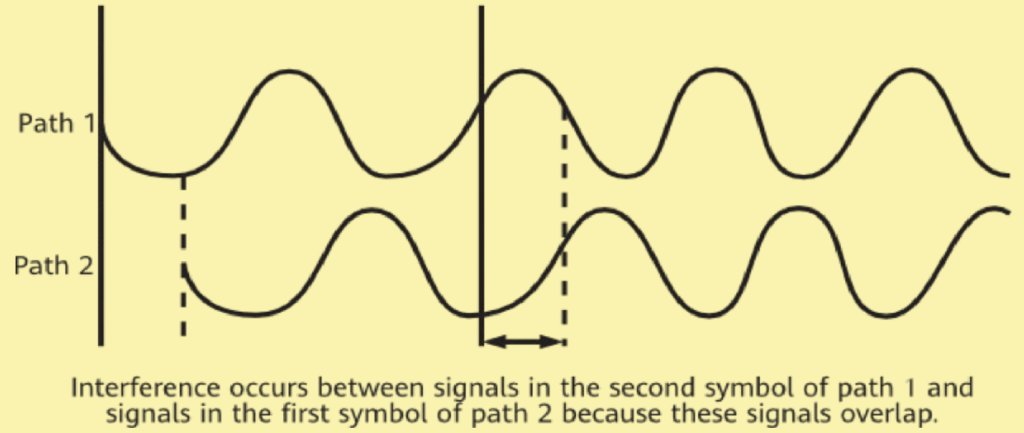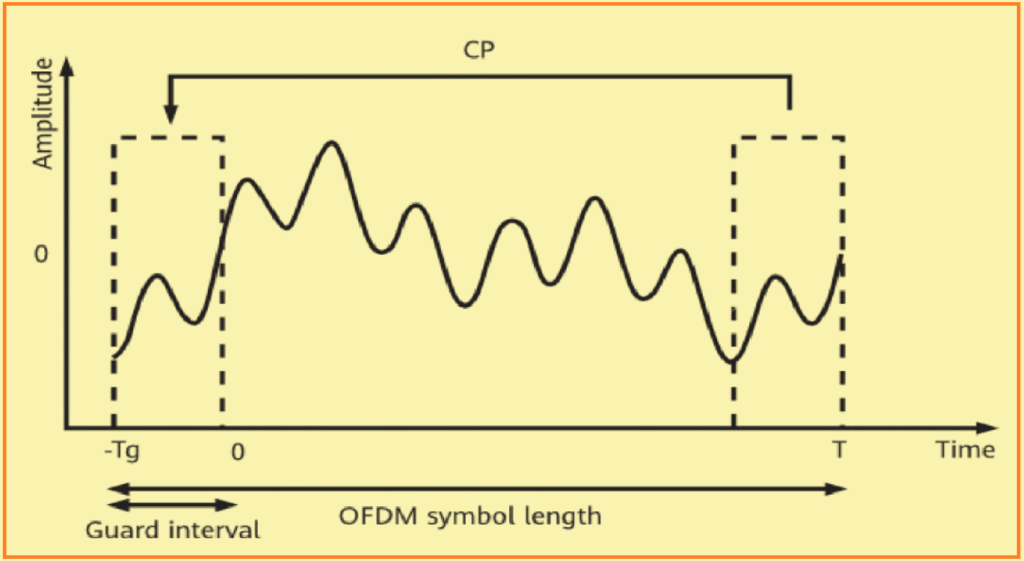In 5G New Radio (NR), the structure of Orthogonal Frequency-Division Multiplexing (OFDM) symbols includes both a data transmission part and a cyclic prefix (CP), similar to LTE. The subcarrier spacing (SCS) plays a crucial role in determining the lengths of the data transmission part, symbol, and CP. This structure allows 5G NR to efficiently handle various use cases and channel conditions.
Numerology and OFDM Symbols
The SCS in 5G NR can vary, which leads to different lengths for the data transmission part, CP, and overall symbol length. The table below shows how these parameters change with different SCS values (numerology denoted by μ).
| Numerology (μ) | 0 | 1 | 2 | 3 | 4 |
| SCS (KHz) | 15 | 30 | 60 | 120 | 240 |
| Data transmission part length (us) TData = 1/SCS | 66.67 | 33.33 | 16.67 | 8.33 | 4.17 |
| CP length (us) Tcp = 144/2048 x TData | 4.69 | 2.34 | 1.17 | 0.59 | 0.29 |
| Length of symbols containing CPs (us) Tsymbol = TData + Tcp | 71.35 | 35.68 | 17.74 | 8.92 | 4.46 |
| Slot Length (ms) Tslot = 14 x Tsymbol | 1 | 0.5 | 0.25 | 0.125 | 0.625 |
The length of each slot is fixed by the number of symbols it contains, but the duration of each slot varies with the SCS.
Role of the Cyclic Prefix (CP)
CPs are inserted between OFDM symbols to prevent inter-symbol interference (ISI) and inter-carrier interference (ICI) caused by multipath propagation.
Inter-Symbol Interference (ISI):
Multipath propagation results in signal reflections and refractions, causing delayed signal arrivals at the receiver. This delay difference leads to ISI, where signals from one symbol overlap with those of another.
Figure 1. ISI caused by multipath propagation.

To mitigate ISI, CPs act as guard intervals, ensuring that the delay spread does not cause overlapping between symbols. The CP length must be greater than the maximum delay spread to be effective.
Inter-Carrier Interference (ICI):
ICI occurs when the orthogonality of subcarriers is destroyed, either due to signal distortion from multipath propagation or the insertion of an empty guard interval.
Figure 2. ICI caused by multipath propagation.

To maintain orthogonality, a copy of the end of each data symbol is inserted as the CP at the beginning of the symbol. This ensures that signal copies from multiple paths align within an integer number of waveforms in the Fast Fourier Transform (FFT) period, preserving orthogonality and mitigating ICI.
Frequency Range and SCS.
5G spectrum is divided into two frequency ranges:
- FR1 (Sub-6 GHz): Supports SCS as low as 15 kHz.
- FR2 (mmWave, 24-52 GHz): Requires a minimum SCS of 60 kHz due to higher frequencies and larger delay spreads.
For FR2, the standard CP might not suffice due to significant multipath effects. Hence, an extended CP is introduced, particularly for scenarios with 60 kHz SCS. The length of the extended CP is 4.17 µs, which helps to counteract the larger delay spreads in these high-frequency environments.
Conclusion.
The structure of OFDM symbols and the use of CPs in 5G NR are designed to handle the challenges posed by various channel conditions and service requirements. By varying the SCS and introducing extended CPs for higher frequency ranges, 5G NR can efficiently manage ISI and ICI, ensuring robust communication even in complex propagation environments.
References
- 3GPP TS 38.300, NR and NG-RAN Overall Description; Stage 2 (Release 16)
- 3GPP TS 38.101-1, User Equipment (UE) radio transmission and reception; Part 1: Range 1 Standalone (Release 16)
- 3GPP TS 38.101-2, User Equipment (UE) radio transmission and reception; Part 1: Range 2 Standalone (Release 16).
- 3GPP TS 38.104, Base Station (BS) radio transmission and reception (Release 16).
- 3GPP TS 36.211, Physical channels and modulation (Release 14).
- 3GPP TS 38.213, Physical layer procedures for control (Release 16).
- 3GPP TS 38.211, Physical channels and modulation (Release 16).
- 3GPP TR 38.912 (Release 15).
- 3GPP TR 38.802, Physical Layer Aspects (Release 14).
Following questions are asked during interview of 5G NR RAN, RF and Microwave on topic of Time Domain Resources.
- Where do the basic time units Tc and Ts in the 5G system come from?
- What are intersymbol interference (ISI) and inter-subcarrier interference (ICI)?
- Why can extended cyclic prefixes (CPs) avoid the interference?
- What are slot formats?
- What is mini-slot?
- How do 3GPP specifications describe mini-slot?